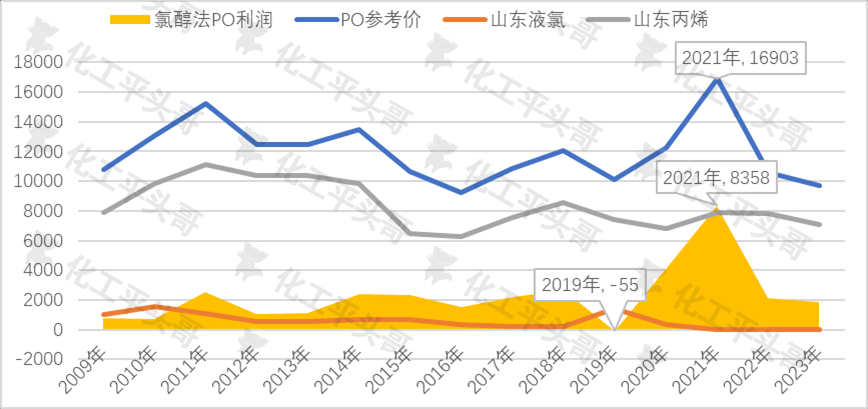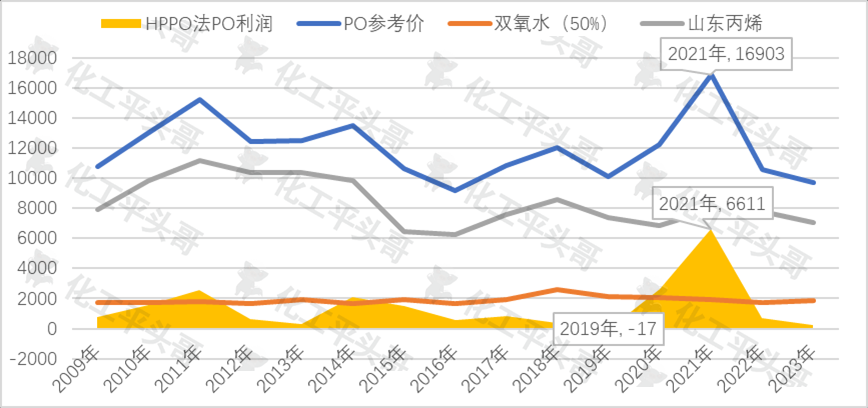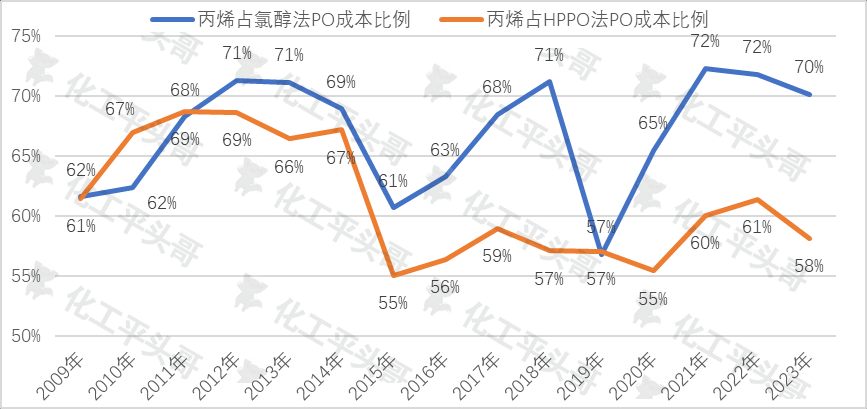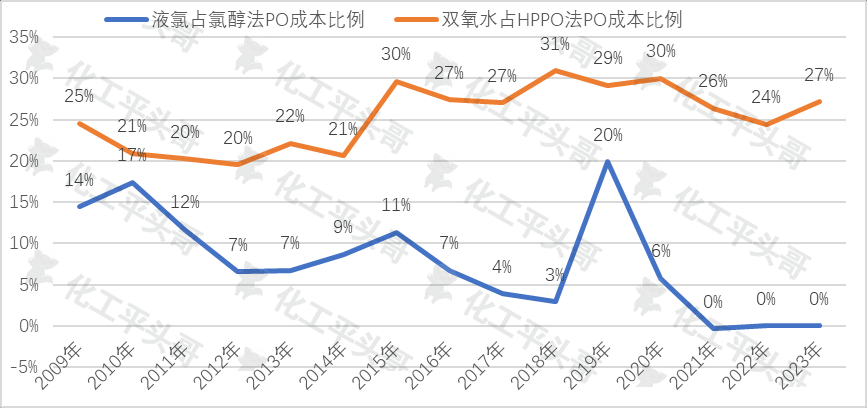In recent years, the technological process of China’s chemical industry has made significant progress, which has led to the diversification of chemical production methods and the differentiation of chemical market competitiveness. This article mainly delves into the different production processes of epoxy propane.
According to the investigation, strictly speaking, there are three production processes for epoxy propane, namely the chlorohydrin method, co oxidation method (Halcon method), and hydrogen peroxide direct oxidation method (HPPO). At present, the chlorohydrin method and HPPO method are the mainstream processes for the production of epoxy propane.
Chlorohydrin method is a method of producing epoxy propane using propylene and chlorine gas as raw materials through processes such as chlorohydrination, saponification, and distillation. This process has a high yield of epoxy propane, but it also generates a large amount of wastewater and exhaust gas, which has a significant impact on the environment.
The co oxidation method is a process for producing propylene oxide using propylene, ethylbenzene, and oxygen as raw materials. Firstly, ethylbenzene reacts with air to produce ethylbenzene peroxide. Then, ethylbenzene peroxide undergoes a cyclization reaction with propylene to produce epoxy propane and phenylethanol. This process has a relatively complex reaction process and produces many by-products, therefore, it also faces negative impacts on the environment.
The HPPO method is a process of adding methanol, propylene, and hydrogen peroxide in a mass ratio of 4.2:1.3:1 to a reactor containing zeolite titanium silicate catalyst (TS-1) for reaction. This process can convert 98% of hydrogen peroxide, and the selectivity of epoxy propane can reach 95%. A small amount of partially reacted propylene can be recycled back to the reactor for reuse.
Most importantly, the epoxy propane produced by this process is currently the only product allowed for export in China.
We calculate the price trend from 2009 to mid 2023 and observe the changes in the production of epichlorohydrin and HPPO processes over the past 14 years.
Epichlorohydrin method
1.The epichlorohydrin method is profitable for most of the time. In the past 14 years, the production profit of epichlorohydrin by chlorohydrin method reached the highest at 8358 yuan/ton, which occurred in 2021. However, in 2019, there was a slight loss of 55 yuan/ton.
2.The profit fluctuation of epichlorohydrin method is consistent with the price fluctuation of epichlorohydrin. When the price of epoxy propane increases, the production profit of epichlorohydrin method also increases accordingly. This consistency reflects the common impact of changes in market supply and demand and product value on the prices of the two products. For example, in 2021, due to the pandemic, the consumption of soft foam polyether significantly increased, which in turn drove up the price of epoxy propane, ultimately creating a historical high in the profit margin of epichlorohydrin production.
3.The price fluctuations of propylene and propylene oxide exhibit long-term trend consistency, but in most cases, there is a significant difference in the fluctuation amplitude between the two. This indicates that the prices of propylene and epichlorohydrin are influenced by different factors, with propylene prices having a particularly significant impact on epichlorohydrin production. Due to the fact that propylene is the main raw material for epichlorohydrin production, its price fluctuations will have a significant impact on the production cost of epichlorohydrin production.
Overall, the production profit of epichlorohydrin in China has been in a profitable state for most of the past 14 years, and its profit fluctuations are consistent with the price fluctuations of epichlorohydrin. Propylene prices are an important factor affecting the production profit of epichlorohydrin in China.
HPPO method epoxy propane
1.The Chinese HPPO method for epoxypropane has been profitable for most of the time, but its profitability is generally lower compared to the chlorohydrin method. In a very short period of time, the HPPO method experienced losses in epoxy propane, and for most of the time, its profit level was significantly lower than that of the chlorohydrin method.
2.Due to the significant increase in the price of epoxy propane in 2021, the profit of HPPO epoxy propane reached a historical high in 2021, reaching a maximum of 6611 yuan/ton. However, there is still a gap of nearly 2000 yuan/ton between this profit level and the chlorohydrin method. This indicates that although the HPPO method has advantages in certain aspects, the chlorohydrin method still has significant advantages in terms of overall profitability.
3.In addition, by calculating the profit of the HPPO method using a 50% hydrogen peroxide price, it was found that there is no significant correlation between the price of hydrogen peroxide and the price fluctuations of propylene and propylene oxide. This indicates that the profit of China’s HPPO method for epoxypropane is constrained by the prices of propylene and high concentration hydrogen peroxide. Due to the close correlation between the price fluctuations of these raw materials and intermediate products and factors such as market supply and demand and production costs, it has had a significant impact on the production profit of epoxy propane using the HPPO method
The production profit fluctuation of China’s HPPO method epoxy propane in the past 14 years has shown a characteristic of being profitable for most of the time but with a low level of profitability. Although it has advantages in certain aspects, overall, its profitability still needs to be improved. At the same time, the profit of HPPO method epoxy propane is greatly affected by the price fluctuations of raw materials and intermediate products, especially propylene and high concentration hydrogen peroxide. Therefore, manufacturers need to closely monitor market trends and adjust production strategies reasonably to achieve the best profit level.
The impact of main raw materials on their costs under two production processes
1.Although the profit fluctuations of epichlorohydrin method and HPPO method show consistency, there are significant differences in the impact of raw materials on their profits. This difference indicates that there are differences in cost management and profit control capabilities between these two production processes when dealing with fluctuations in raw material prices.
2.In the chlorohydrin method, the proportion of propylene to cost reaches an average of 67%, accounting for more than half of the time, and reaching a maximum of 72%. This indicates that in the production process of chlorohydrin, the cost of propylene has the greatest impact on weight. Therefore, the fluctuation of propylene price has a direct impact on the cost and profit of epichlorohydrin production by chlorohydrin method. This observation is consistent with the long-term trend of profit and propylene price fluctuations in the production of epichlorohydrin by the chlorohydrin method mentioned earlier.
In contrast, in the HPPO method, the average impact of propylene on its cost is 61%, with some having the highest impact at 68% and the lowest at 55%. This indicates that in the HPPO production process, although the cost impact weight of propylene is large, it is not as strong as the impact of chlorohydrin method on its cost. This may be due to the significant impact of other raw materials such as hydrogen peroxide used in the HPPO production process on costs, thereby reducing the impact of propylene price fluctuations on costs.
3.If the price of propylene fluctuates by 10%, the cost impact of chlorohydrin method will exceed that of HPPO method. This means that when facing fluctuations in propylene prices, the cost of the chlorohydrin method is more affected, and relatively speaking, the HPPO method has better cost management and profit control capabilities. This observation once again highlights the differences in response to fluctuations in raw material prices among different production processes.
There is consistency in profit fluctuations between the Chinese chlorohydrin method and the HPPO method for epoxy propane, but there are differences in the impact of raw materials on their profits. When dealing with fluctuations in raw material prices, the two production processes exhibit different cost management and profit control capabilities. Among them, the chlorohydrin method is more sensitive to the fluctuation of propylene price, while the HPPO method has good risk resistance. These laws have important guiding significance for enterprises to choose production processes and formulate production strategies.
The impact of auxiliary materials and raw materials on their costs under two production processes
1.The impact of liquid chlorine on the cost of epichlorohydrin production by chlorohydrin method has averaged only 8% over the past 14 years, and can even be considered to have almost no direct cost impact. This observation indicates that liquid chlorine plays a relatively minor role in the production process of chlorohydrin, and its price fluctuations have little impact on the cost of epichlorohydrin produced by chlorohydrin.
2.The cost impact of high concentration hydrogen peroxide on the HPPO method of epoxy propane is significantly higher than that of chlorine gas on the cost impact of chlorohydrin method. Hydrogen peroxide is a key oxidant in the HPPO production process, and its price fluctuations have a direct impact on the cost of epoxy propane in the HPPO process, second only to propylene. This observation highlights the important position of hydrogen peroxide in the HPPO production process.
3.If the enterprise produces its own by-product chlorine gas, the cost impact of chlorine gas on epichlorohydrin production can be ignored. This may be due to the relatively small amount of by-product chlorine gas, which has a relatively limited impact on the cost of epichlorohydrin production using chlorohydrin.
4.If a 75% concentration of hydrogen peroxide is used, the cost impact of hydrogen peroxide on the HPPO method of epoxy propane will exceed 30%, and the cost impact will continue to rapidly increase. This observation indicates that the epoxy propane produced by the HPPO method is not only affected by significant fluctuations in the raw material propylene, but also by significant fluctuations in the price of hydrogen peroxide. Due to the increase in the concentration of hydrogen peroxide used in the HPPO production process to 75%, the amount and cost of hydrogen peroxide also increase accordingly. There are more market influencing factors, and the volatility of its profits will also increase, which will have a greater impact on its market price.
There is a significant difference in the cost impact of auxiliary raw materials for the production processes of epichlorohydrin using the chlorohydrin method and the HPPO method. The impact of liquid chlorine on the cost of epichlorohydrin produced by chlorohydrin method is relatively small, while the impact of hydrogen peroxide on the cost of epichlorohydrin produced by HPPO method is more significant. At the same time, if a company produces its own by-product chlorine gas or uses different concentrations of hydrogen peroxide, its cost impact will also vary. These laws have important guiding significance for enterprises to choose production processes, formulate production strategies, and carry out cost control.
Based on current data and trends, the ongoing projects of epoxy propane in the future will exceed the current scale, with most of the new projects adopting the HPPO method and ethylbenzene co oxidation method. This phenomenon will lead to an increase in demand for raw materials such as propylene and hydrogen peroxide, which will have a greater impact on the cost of epoxy propane and the overall cost of the industry.
From a cost perspective, enterprises with an integrated industrial chain model can better control the impact weight of raw materials, thereby reducing costs and improving market competitiveness. Due to the fact that most new projects for epoxy propane in the future will adopt the HPPO method, the demand for hydrogen peroxide will also increase, which will increase the weight of the impact of hydrogen peroxide price fluctuations on the cost of epoxy propane.
In addition, due to the use of ethylbenzene co oxidation method in new projects of epoxy propane in the future, the demand for propylene will also increase. Therefore, the weight of the impact of propylene price fluctuations on the cost of epoxy propane will also increase. These factors will bring more challenges and opportunities to the epoxy propane industry.
Overall, the development of the epoxy propane industry in the future will be influenced by ongoing projects and raw materials. For enterprises adopting HPPO and ethylbenzene co oxidation methods, more attention needs to be paid to cost control and industrial chain integration development. For raw material suppliers, it is necessary to strengthen the stability of raw material supply and control costs to improve market competitiveness.
Post time: Sep-08-2023








